|
 |
 Автор: Williams Автор: Williams
 Дата: 3 февраля 2021 Дата: 3 февраля 2021
 Просмотров: 2 675 Просмотров: 2 675 |
| |
ANSYS products 2021 R1 x64 + docs
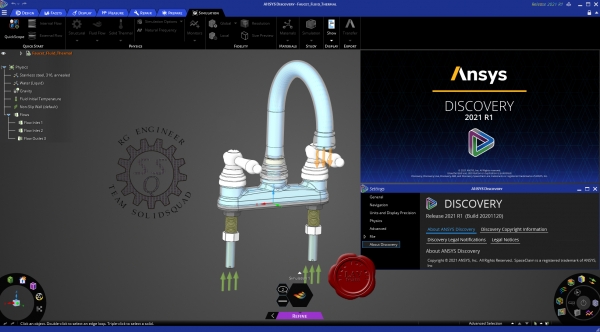
ANSYS - многоцелевой конечно-элементный пакет для проведения анализа в широкой области инженерных дисциплин. Это универсальный, "тяжелый" конечно элементный пакет, предназначенный для решения в единой среде на одной и той же конечно-элементной модели задач по прочности, теплу, электромагнетизму, гидрогазодинамике, многодисциплинарного связанного анализа и оптимизации на основе всех выше приведенных типов анализа.
Сотни новых возможностей ANSYS согласуются с общей стратегией развития компании – разработка универсального и многофункционального программного обеспечения, соответствующего изменяющимся требованиям клиентов. Новый релиз разрабатывался с учетом требований клиентов, активно использующих стратегию ANSYS, которая получила название Simulation Driven Product Development.
Семейство продуктов ANSYS
Professional
Высокоэффективный комбинированный пакет, предназначен для расчета линейных статических задач прочности, модального анализа, стационарных и нестационарных задач теплофизики, включая теплопроводность, конвекцию и радиационный обмен. ANSYS Professional ориентирован на инженеров среднего звена.
Structural
Полный прочностной пакет (за исключением функций расчета гидрогазодинамики, тепла, электромагнетизма), включает функции прочностного анализа, расчеты линейной прочности, нелинейности (деформации, упругость, пластичность, текучесть, расчет элементов на растяжение-сжатие и др.). Контактные задачи. Частотная область динамического анализа (гармонический, спектральный, вибрации). Динамический анализ неустановившихся процессов; устойчивость конструкций; механика разрушений линейных и нелинейных задач для изделий из композиционных и армированных материалов, включая температурные воздействия. Совместный анализ, акустика.
Mechanical
Этот пакет прочностного анализа и тепла (за исключением функций расчета гидрогазодинамики и электромагнетизма) является наиболее универсальным модулем, позволяющим выполнять большинство линейных и нелинейных задач конечно-элементного анализа. Включает в себя все возможности, перечисленные в Structural, в сочетании с функциями расчета тепла (стационарный и нестационарный режимы, теплопроводность, радиация, конвекция).
Multiphysics
Наиболее полный пакет, включающий в себя все возможные физические дисциплины (прочность и тепло), а также электромагнитный анализ (магнитостатика, электростатика, электропроводность, низкочастотный гармонический анализ, высокочастотный анализ) и гидрогазодинамику (стационарная и нестационарная, сжимаемые и несжимаемые, ламинарные и турбулентные потоки; естественная и вынужденная конвекция, сопряженный теплоперенос; вязкие и многокомпонентные течения; фильтрация).
Emag
Специальный модуль расчета электростатики и магнитостатики, низкочастотного и высокочастотного анализа, нестационарных задач.
LS-DYNA
Программа высоконелинейных расчетов LS-DYNA, интегрированная в среду ANSYS, объединяет в одной программной оболочке традиционные методы решения с обращением матриц, специализированные контактные алгоритмы, множество уравнений состояния и метод интегрирования, что позволяет численно моделировать процессы формования материалов, анализа аварийных столкновений и ударов при конечных деформациях, при нелинейном поведении материала и контактном взаимодействии большого числа тел. С использованием LS-DYNA могут быть решены задачи динамического поведения предварительно напряженных конструкций и задачи исследования разгрузки конструкций, подвергнутых большим деформациям.
ICEM CFD
Комплексная система генерации любых типов расчетных сеток имеющая прямой интерфейс с CAD системами (Pro/E, Catia, Unigraphics,I-DEAS, SDRC, ICEM Surf). Экспорт сетки, более чем в 100 пакетов гидрогазодинамического и структурного анализа. Анализ и исправление геометрии, пре и пост-процессинг, адаптивная оптимизация сетки - это лишь основные ключевые моменты, позволяющие ускорить генерацию качественной сетки на основе любой геометрии.
CFX
Программный комплекс, сочетающий уникальные возможности анализа гидрогазодинамических процессов, многофазных потоков, химической кинетики, горения, радиационного теплообмена и многих других. CFX обеспечивает принципиально новый уровень решения задач вычислительной гидрогазодинамики за счет уникального сочетания технологий, начиная от прямого интерфейса к большинству CAD систем и заканчивая возможностью проводить сопряженный жидкостно-структурный анализ совместно с ANSYS Multiphysics. Широкий выбор моделей турбулентности, в сочетании с линейным решателем с технологией "Algebraic Coupled Multigrid" позволяет добиться высокой точности результатов при решении различного класса задач.
Workbench
Новое поколение программных продуктов, в основе которых современный объектно-ориентированный подход к инженерному анализу, используя при этом возможности решателей ANSYS. Эта среда инженерного анализа предоставляет уникальные возможности по интеграции с CAD системами (в том числе двунаправленную ассоциативную связь). Можно сочетать процесс проектирования в CAD пакете с получением достоверных данных расчетов и проведением оптимизации конструкции.
PrepPost
Отдельный пре- и постпроцессор с полным набором возможностей по созданию, импорту и экспорту геометрических моделей, по построению, импорту и экспорту конечно-элементных сеток, по постановке задачи и обработке результатов (визуализация, листинг, операции над результатами и др.). Является полнофункциональной рабочей средой и обладает всеми ее функциями за исключением собственно решения задачи. Возможно использование нескольких рабочих мест ANSYS PrepPost в комбинации с любым расчетным продуктом.
Геометрический моделировщик
Предназначен для создания геометрических моделей с помощью графических примитивов, операций с ними и их параметрического описания. Построение твердотельной модели в ANSYS возможно с помощью комбинации двух вариантов: при помощи булевых операций набора готовых примитивов или при помощи последовательного иерархического построения, начиная с опорных точек, затем - линий, сплайнов и далее - до твердого тела. Наличие этих вариантов построения дает гибкие возможности для быстрого создания сложных моделей. Поддерживается двусторонний обмен данных посредством импорта моделей с большинством CAD-систем, включая UG, Pro/E, а также чтение нейтральных геометрических форматов IGES, SAT, STEP и др.
Параллельные и многопроцессорные системы
Дополнительный модуль параллельных вычислений Parallel Performance for ANSYS позволяет решать большие задачи как на кластерах. |
| |
 Читать статью дальше (комментариев - 11)
Читать статью дальше (комментариев - 11)
| |
|
 |
 Автор: Williams Автор: Williams
 Дата: 2 февраля 2021 Дата: 2 февраля 2021
 Просмотров: 1 468 Просмотров: 1 468 |
| |
Dlubal SHAPE-MASSIVE v6.74.02
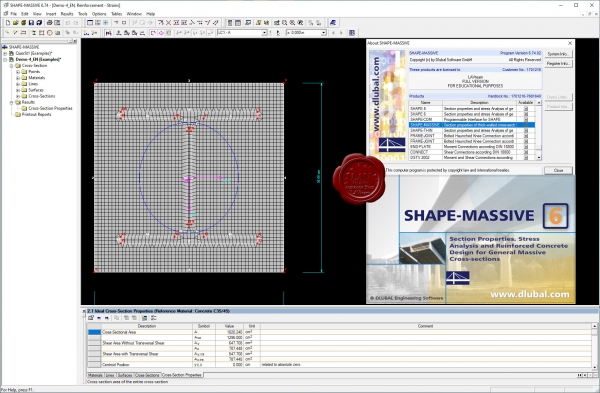
SHAPE-MASSIVE рассчитывает характеристики массивных сечений любой формы и определяет напряжения в них. Кроме того, возможен расчет железобетонных сечений в соответствии с Еврокод 2 и другими нормами. SHAPE-MASSIVE обладает опцией интерфейса для связи с RSTAB и RFEM: сечения SHAPE-MASSIVE доступны в программах для расчета каркасов по МКЭ, и наоборот, возможен импорт внутренних сил из RSTAB и RFEM в SHAPE-MASSIVE для расчета. Сечения могут быть заданы графически, в табличной форме или импортированы в виде файла формата DXF.
|
| |
 Читать статью дальше (комментариев - 5)
Читать статью дальше (комментариев - 5)
| |
|
 |
 Автор: Williams Автор: Williams
 Дата: 1 февраля 2021 Дата: 1 февраля 2021
 Просмотров: 2 413 Просмотров: 2 413 |
| |
Lincoln Agritech IRRICAD v18.06 repack
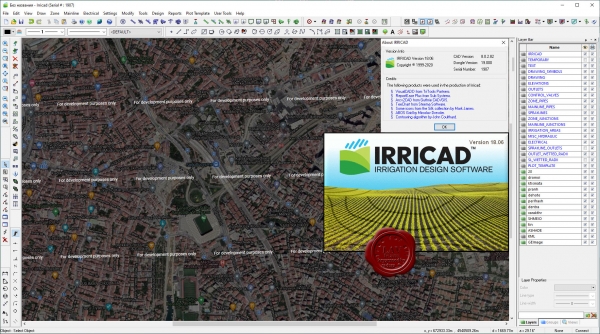
IRRICAD is the global leader in irrigation design software, developed by irrigation engineers at Lincoln Agritech. IRRICAD is used for designing all types of pressurised irrigation systems from concept through to completion; it is the essential design package. The program allows for rapid analysis of complex hydraulic systems, which facilitates faster design changes. The IRRICAD program comes with fully cutomisable databases from major irrigation suppliers. Established in 1988, today IRRICAD is distributed globally and is sold to over 90 countries across multiple continents including Australasia, North and South America, Europe, the Middle East, Africa, China and Asia.
Added revision allows to use loader+emu without Multikey using. No additional drivers = no additional conflicts :-) |
| |
 Читать статью дальше (комментариев - 33)
Читать статью дальше (комментариев - 33)
| |
|
 |
 Автор: Williams Автор: Williams
 Дата: 31 января 2021 Дата: 31 января 2021
 Просмотров: 5 088 Просмотров: 5 088 |
| |
CSI SAP2000 v23.0.0 build 1697 x64
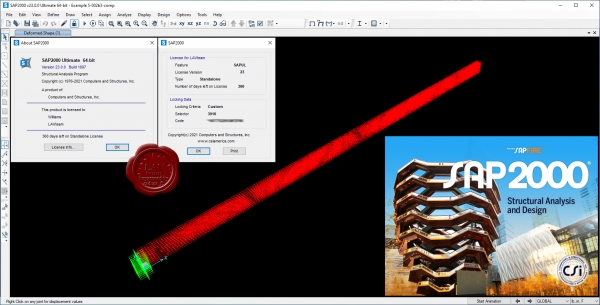
CSI SAP2000 - cистема трехмерного статического и динамического анализа методом конечных элементов и проектирования сооружений.
SAP2000 следует принципам, основными чертами которых являются современный, интуитивно понятный и универсальный пользовательский интерфейс, основанный на уникальном расчетном ядре и инструментах проектирования конструкций для инженеров, разрабатывающих объекты транспортной инфраструктуры, промышленные и гражданские здания, спортивные сооружения и другие объекты.
Начиная с трехмерной объектно-ориентированной рабочей среды моделирования и до широчайшего спектра опций расчета и проектирования конструкций, комплексно интегрированных в один мощный пользовательский интерфейс, SAP2000 – это наиболее интегрированный, производительный и практичный расчетный комплекс общего назначения, существующий на сегодняшнем рынке. Интуитивно понятный интерфейс позволяет Вам создавать модели конструкций в кратчайшие сроки без долгого процесса обучения. Сегодня Вы можете использовать SAP2000 для всех Ваших задач по расчету и проектированию, в том числе и для небольших повседневных задач.
Комплексные модели могут быть созданы и разбиты на конечные элементы с использованием встроенных шаблонов. Интегрированные инструменты проектирования конструкций способны автоматически сгенерировать ветровые, волновые, нагрузки от транспорта и сейсмические нагрузки на модель, а также выполнить полную автоматическую проверку стальных и железобетонных элементов согласно нормам проектирования различных стран.
|
| |
 Читать статью дальше (комментариев - 35)
Читать статью дальше (комментариев - 35)
| |
|
 |
 Автор: Williams Автор: Williams
 Дата: 30 января 2021 Дата: 30 января 2021
 Просмотров: 1 225 Просмотров: 1 225 |
| |
Randy Shih - SolidWorks 2020 and Engineering Graphics
SDC Publications, 2020
pdf, 726 pages, english
ISBN: 978-1-63057-318-8
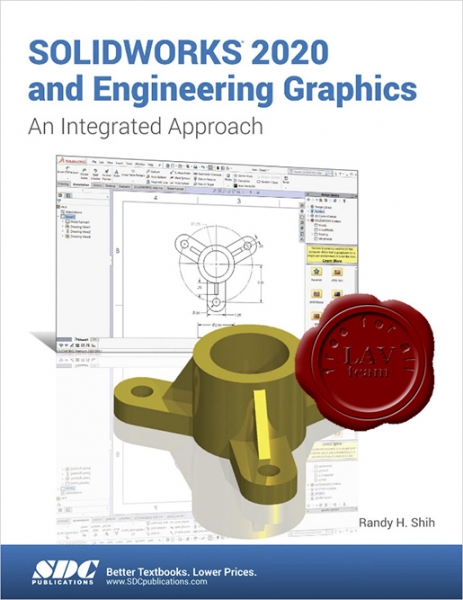
SolidWorks 2020 and Engineering Graphics: An Integrated Approach combines an introduction to SolidWorks 2020 with a comprehensive coverage of engineering graphics principles. Not only will this unified approach give your course a smoother flow, your students will also save money on their textbooks. What s more, the exercises in this book cover the performance tasks that are included on the Certified SolidWorks Associate (CSWA) Examination. Reference guides located at the front of the book and in each chapter show where these performance tasks are covered.
The primary goal of SolidWorks 2020 and Engineering Graphics: An Integrated Approach is to introduce the aspects of Engineering Graphics with the use of modern Computer Aided Design package SolidWorks 2020. This text is intended to be used as a training guide for students and professionals.
The chapters in this text proceed in a pedagogical fashion to guide you from constructing basic shapes to making complete sets of engineering drawings. This text takes a hands-on, exercise-intensive approach to all the important concepts of Engineering Graphics, as well as in-depth discussions of parametric feature-based CAD techniques.
This textbook contains a series of sixteen chapters, with detailed step-by-step tutorial style lessons, designed to introduce beginning CAD users to the graphics language used in all branches of technical industry. This book does not attempt to cover all of SolidWorks 2020 s features, only to provide an introduction to the software. It is intended to help you establish a good basis for exploring and growing in the exciting field of Computer Aided Engineering. |
| |
 Читать статью дальше (комментариев - 9)
Читать статью дальше (комментариев - 9)
| |
|
 |
 Автор: Williams Автор: Williams
 Дата: 29 января 2021 Дата: 29 января 2021
 Просмотров: 3 792 Просмотров: 3 792 |
| |
Agisoft Metashape Pro v1.7.1 build 11797 x64
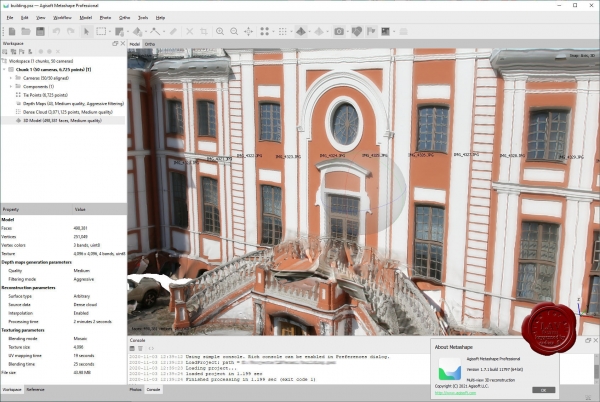
Agisoft Metashape Professional - это передовое программное обеспечение, максимально раскрывающее возможности фотограмметрии, а также включающее в себя технологии машинного обучения для анализа и пост-обработки, что позволяет получать максимально точные результаты.
Metashape позволяет обрабатывать изображения, получаемые с помощью RGB- или мультиспектральных камер, включая мультикамерные системы, преобразовывать снимки в плотные облака точек, текстурированные полигональные модели, геопривязанные ортофотопланы и цифровые модели рельефа/местности (ЦМР/ЦММ).
Дальнейшая постобработка позволяет удалять тени и искажения текстур с поверхности моделей, рассчитывать вегетационные индексы и составлять файлы предписаний для агротехнических мероприятий, автоматически классифицировать плотные облака точек и т.д.
Возможность экспорта во все внешние пакеты для постобработки делает Agisoft Metashape Professional универсальным фотограмметрическим инструментом.
|
| |
 Читать статью дальше (комментариев - 20)
Читать статью дальше (комментариев - 20)
| |
|
 |
 Автор: Williams Автор: Williams
 Дата: 27 января 2021 Дата: 27 января 2021
 Просмотров: 4 255 Просмотров: 4 255 |
| |
Trimble Tekla Structural Design Suite 2020 SP6:
Designer v20.0.6.29, Tedds v22.3.0000, Engineering Library v22.9.0001
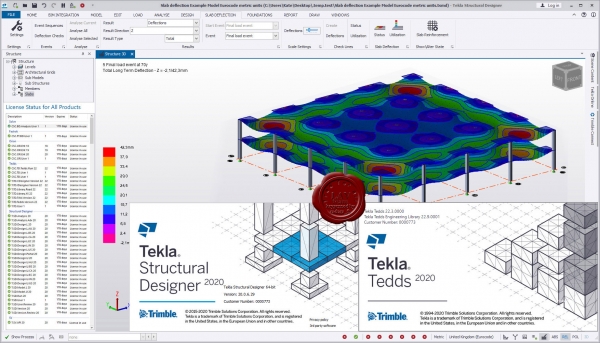
Tekla Structural Designer - мощный инструмент для анализа и проектирования зданий, созданного для инженеров-проектировщиков, работающих в сфере проектирования коммерческих строительных объектов. Tekla Structural Designer дополняет основную программу Tekla Structures и позволяет полноценно использовать все преимущества 3D-моделирования, благодаря единому рабочему процессу, включающему и анализ и проектирование. Tekla Structural Designer - это интеллектуальная загрузка данных, широкий набор аналитических функций, полная автоматизация проектирования, высокое качество документации и готовая полноценная система BIM-моделирования. Все это помогает инженерам повысить эффективность и сократить расходы/издержки при создании проектов.
Tekla Structural Designer предлагает мощные инструменты для работы с железобетонными и металлическими конструкциями, позволяя инженерам быстро сравнивать различные варианты схем проектирования, эффективно управлять изменениями, а также создавать удобную среду для совместной работы. Полностью автоматизированное проектирование и анализ, улучшенные инструменты и повышенная производительность позволяют инженерам предлагать больше альтернативных вариантов проектов, независимо от размера и сложности объекта, тем самым обеспечивая высокое качество обслуживания заказчика.
Эффективное использование BIM-технологий - именно это было в умах разработчиков при создании Tekla Structural Designer. Используя Tekla Structural Designer, инженеры могут неоднократно синхронизировать модели с Tekla Structures и другими программами без ущерба для ключевых проектных данных. Постоянный аудит инструментов в Tekla Structural Designer позволяет инженерам видеть, что было добавлено, изменено или удалено в процессе интеграции, тем самым уменьшая риск ошибок и повышая эффективность сотрудничества с другими членами команды проекта, в том числе техниками, переработчиками и архитекторами. Tekla Structural Designer создает внутреннюю связь и эффективную коммуникацию между всеми специалистами, работающими над проектом.
|
| |
 Читать статью дальше (комментариев - 20)
Читать статью дальше (комментариев - 20)
| |
|
 |
| ПОИСК ПО САЙТУ |
 |
|
 |
| КАЛЕНДАРЬ | | |
 |
| « Октябрь 2025 » |
|---|
| Пн | Вт | Ср | Чт | Пт | Сб | Вс |
|---|
| | 1 | 2 | 3 | 4 | 5 | | 6 | 7 | 8 | 9 | 10 | 11 | 12 | | 13 | 14 | 15 | 16 | 17 | 18 | 19 | | 20 | 21 | 22 | 23 | 24 | 25 | 26 | | 27 | 28 | 29 | 30 | 31 | |
|
 | |
| |
|